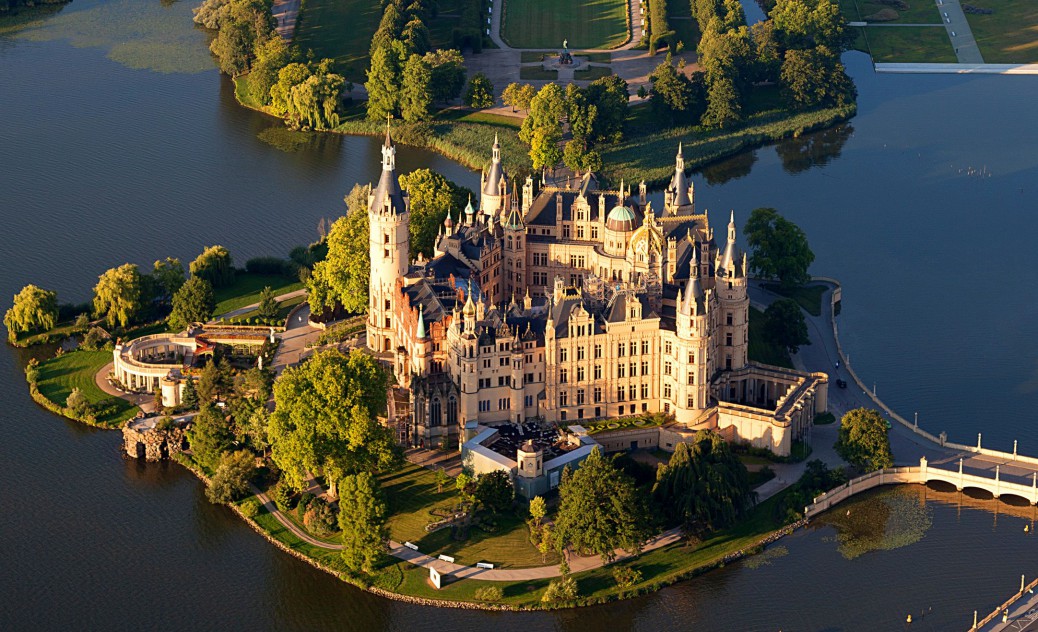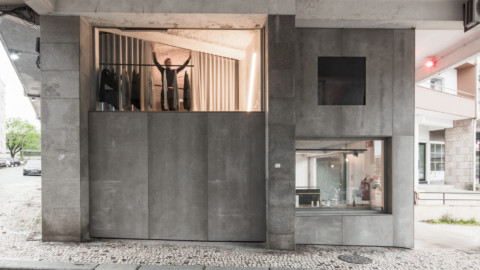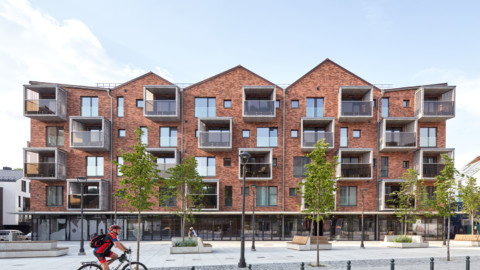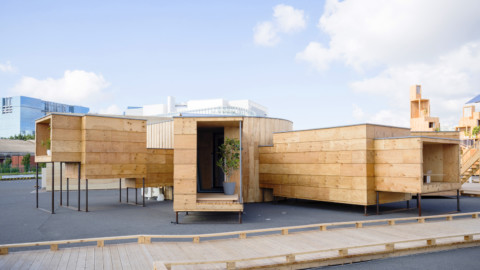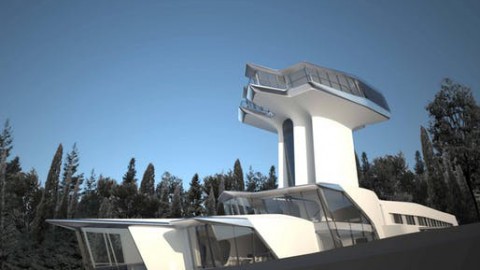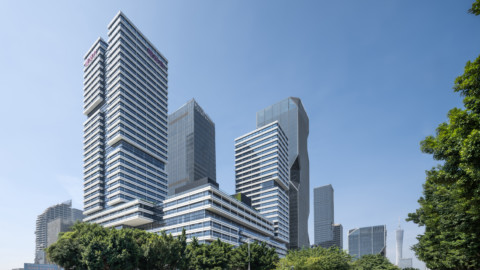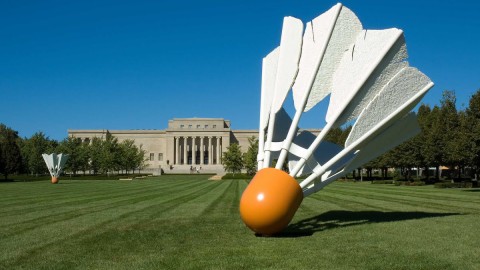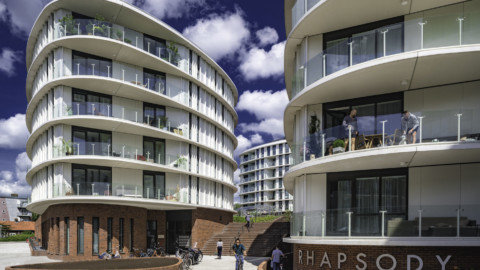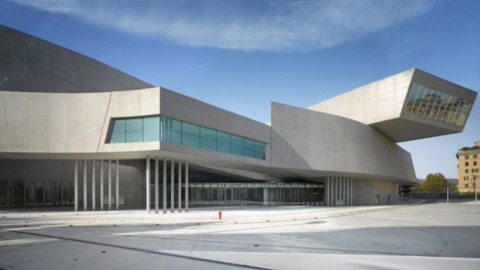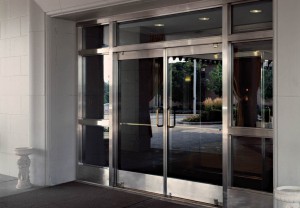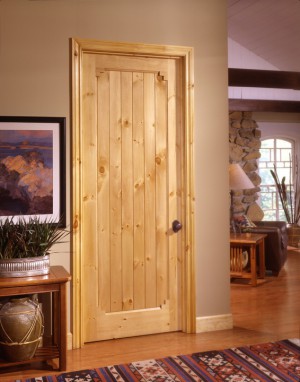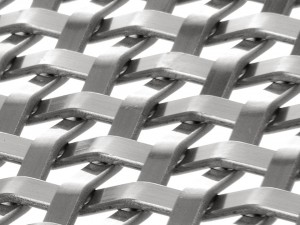Schweriner Schlos 什未林城堡

The Schwerin Palace (also known as Schwerin Castle, German: Schweriner Schloss, German pronunciation: [ʃvɛ ʁiːn’]), is a palatial schloss located in the city of Schwerin, the capital of Mecklenburg-Vorpommern state, Germany. It is situated on an island in the city’s main lake, the Lake Schwerin.
For centuries the palace was the home of the dukes and grand dukes of Mecklenburg and later Mecklenburg-Schwerin. Today it serves as the residence of the Mecklenburg-Vorpommern state parliament (German: Landtag).
Major parts of the current palace were built between 1845 and 1857, as a cooperation of the renowned historicist architects Gottfried Semper, Friedrich August Stüler, Georg Adolf Demmler and Ernst Friedrich Zwirner. The castle is regarded as one of the most important works of romantic Historicism in Europe and is designated to become a World Heritage Site. It is nicknamed “Neuschwanstein of the North”.
什未林宮(也稱為什未林城堡,德語:Schweriner Schloss,德語發音:[ʃvɛɛiːn’]),是位於德國梅克倫堡 – 前波莫瑞州首府什未林市的富麗堂皇的城堡。 它坐落在城市主要湖泊什未林湖的一個島嶼上。
幾個世紀以來,宮殿是梅克倫堡公爵和大公爵以及後來的梅克倫堡 – 什未林的家園。 今天,它是梅克倫堡 – 前波莫瑞州議會的所在地(德語:Landtag)。
當前宮殿的主要部分建於1845年至1857年間,由著名的歷史主義建築師戈特弗里德森佩爾,弗里德里希·奧古斯特·斯圖勒,喬治·阿道夫·德米勒和恩斯特·弗里德里希·茨維納合作。 該城堡被認為是歐洲浪漫歷史主義最重要的作品之一,被指定為世界遺產。 它的綽號是“北方的新天鵝堡”。
General information
Town or city:Schwerin
Country:Mecklenburg-Vorpommern state, Germany
Coordinates:53°37′27″N 11°25′08″ECoordinates: 53°37′27″N 11°25′08″E
Completed:973
一般信息
城鎮:什未林
國家:德國梅克倫堡 – 前波莫瑞州
坐標:53°37’27“N 11°25’08”ECoordinates:53°37’27“N 11°25’08”E
完成:973
History
Early years
The first records of a castle at this location date from AD 973. There was a fort of the Polabian Slav tribe of the Obotrites on an island in the large Lake of Schwerin.
In 1160, the fort became a target of Germanic noblemen planning to expand their territory eastward under the leadership of Henry the Lion (1129–1195). The Obotrites under Niklot destroyed the fort but left because of the Germanic military dominance. The German conquerors however recognised the strategic and aesthetically interesting location of the island and started building a new fort. The foundation of the city of Schwerin took place in the same year. Schwerin became the seat of a bishopric.
In 1167, Henry gave the County of Schwerin to his vassal Gunzelin von Hagen, and the rest of the country around the city was returned to Niklot’s son Pribislav, forming a ducal hereditary line that lasted until 1918. In 1358, the County of Schwerin was purchased by the descendants of Niklot, who had been elevated to Dukes of Mecklenburg in 1348. They soon relocated farther inland from Mikelenburg, near the city of Wismar, to Schwerin. During the late Gothic era, the growing prosperity and position of the dukes led to a growing need for a representative castle, and this meant architectural changes to the fortress settlement. The Bishop’s House (Bischofshaus) from that period remains in a grave.
歷史
早些年
在這個位置的城堡的第一個記錄可以追溯到公元973年。在什未林的大湖中,有一座位於Obotrites的Polabian Slav部落的堡壘。
1160年,堡壘成為日耳曼貴族計劃在獅子亨利(1129-1195)領導下向東擴展領土的目標。 Niklot下的Obotrites摧毀了堡壘但由於日耳曼軍事統治而離開了。然而,德國征服者認識到該島的戰略和美學有趣的位置,並開始建造一個新的堡壘。什未林市的基礎發生在同一年。什未林成為主教的所在地。
1167年,亨利將什未林縣交給他的附庸Gunzelin von Hagen,該城市周圍的其他國家被送回尼可樂的兒子普里比斯拉夫,形成一直持續到1918年的公爵遺傳線。在1358年,什未林縣是由尼克洛的後裔購買,後者於1348年被提升為梅克倫堡公爵。他們很快從內地從維斯馬市附近的邁克倫堡搬到什未林。在哥特時代晚期,公爵的日益繁榮和地位導致對代表性城堡的需求日益增長,這意味著對堡壘定居點的建築改變。那個時期的主教之家(Bischofshaus)仍然在墳墓裡。

Renaissance (15th–17th centuries)
Under John Albert I, Duke of Mecklenburg (1525–1576), the building faced important changes. The fort became a palace, and the defensive functionality of the fortress was replaced with ornamentation and concessions to comfort. The use of terracotta during the Renaissance was dominant in North German architecture, and Schwerin’s terracotta was supplied from Lübeck.
A few years after reworking the main building itself, from 1560 to 1563, John Albert rebuilt the palace’s chapel. It became the first new Protestant church of the state. The architecture was inspired by churches in Torgau and Dresden. The Venetian Renaissance gate, its gable showing the carrying of the cross, was made by Hans Walther (1526–1600), a sculptor from Dresden. Windows on the northern face show biblical illustrations by well-known Dutch artist Willem van den Broeck (“Paludanus”; 1530–1580).
As the ducal residence needed additional defences, despite its island site, some time in the middle of the 16th century bastions were established to the northwest, southwest and southeast. They were probably built by the same Italian architects who, under Francesco a Bornau, also designed the Dömitz Fortress. The bastions were later modified several times, and are still standing today.
Before the Thirty Years’ War, the architect Ghert Evert Piloot, who had entered Mecklenburg’s service in 1612, made plans to completely rebuild the palace in the style of the Dutch Renaissance. In 1617, work began under his supervision, but soon had to cease because of the war. Piloot’s plans were partially realized between 1635 and 1643: the house above the palatial kitchen and that above the chapel were razed and given Dutch Renaissance style façades.
During this period, a half-timbered building was constructed near the chapel to house the archducal collection of paintings. Also, the Teepavillon (tea house) was built. The court moved to Schloss Ludwigslust in 1756.
文藝復興(15-17世紀)
在梅克倫堡公爵約翰艾伯特一世(1525-1576)的指導下,該建築面臨重大變化。堡壘成為一座宮殿,堡壘的防禦功能被裝飾和讓步所取代以舒適。文藝復興時期赤土陶器的使用在北德建築中占主導地位,而什未林的赤土陶器則來自呂貝克。
在重建主樓後的幾年,從1560年到1563年,約翰·艾伯特重建了宮殿的小教堂。它成為該州第一個新的新教教會。該建築的靈感來自托爾高和德累斯頓的教堂。威尼斯文藝復興時期的大門,其山牆上刻著十字架,由德累斯頓的雕塑家漢斯·沃爾特(1526-1600)製作。北面的窗戶展示了著名荷蘭藝術家Willem van den Broeck(“Paludanus”; 1530-1580)的聖經插圖。
由於公爵住宅需要額外的防禦,儘管它的島嶼位置,在16世紀中期的一些時間建立在西北,西南和東南的堡壘。他們可能是由同樣的意大利建築師建造的,他們在Francesco a Bornau的領導下也設計了DömitzFortress。堡壘後來被修改了好幾次,今天仍然站著。
在三十年戰爭之前,1612年進入梅克倫堡服務的建築師Ghert Evert Piloot計劃以荷蘭文藝復興風格完全重建宮殿。 1617年,工作在他的監督下開始,但很快因戰爭而不得不停止。 Piloot的計劃在1635年至1643年間部分實現:富麗堂皇的廚房上方和教堂上方的房屋被夷為平地,並賦予了荷蘭文藝復興風格的外觀。
在此期間,在教堂附近建造了一座半木結構的建築,用於收藏各種繪畫作品。此外,還建造了Teepavillon(茶館)。法院於1756年遷至Schloss Ludwigslust。

Recent times (since the 19th century)
In 1837, the ducal residence moved back to Schwerin, but the building was in a relatively bad condition, and the Grand Duke disliked the individual buildings’ incongruent origins and architectural styles.
Grand Duke Friedrich (1800–1842) instructed his architect Georg Adolph Demmler (1804–1886) to remodel the palace. However a few months later, construction was halted by his successor, Friedrich Franz II (1823–1883), who wanted a complete reconstruction of the historic site. Only some parts of the building dating from the 16th and 17th century were retained.
Dresden architect Gottfried Semper (1803–1879) and Berlin architect Friedrich August Stüler (1800–1865) could not convince the Grand Duke of their plans. Instead, Demmler included elements of both of them into his plan, but found inspiration in French Renaissance castles. The castle became the most admired masterpiece of the student of Karl Friedrich Schinkel. He also planned a government building in 1825-1826 located at Schlossstraße (today the State Chancellery). Renaissance châteaux of the Loire Valley (such as Chambord) also inspired him and contributed to the construction from 1843 until 1851. His successor Stüler again made a few alterations, and included an equestrian statue of Niklot and the cupola.
Heinrich Strack (1805–1880) from Berlin was chosen for the interior design. Most of the work was carried out by craftsmen from Schwerin and Berlin. A fire destroyed about a third of the palace in December 1913. Only the exterior reconstruction had been completed when the revolution in 1918 resulted in the abdication of the Grand Duke. The castle later became a museum and in 1948 the seat of the state parliament. The German Democratic Republic used the palace as a college for kindergarten teachers from 1952 to 1981. Then it was a museum again until 1993. The Orangerie had been a technical museum since 1961. From 1974 on, some renovated rooms were used as an art museum.
Since late 1990, it is once again a seat of government, as the seat of the Landtag (the state assembly of the State of Mecklenburg-Vorpommern). Since then there have been massive preservation and renovation efforts. Most of these were finished by 2019.
近期(自19世紀以來)
1837年,公爵住宅搬回了什未林,但該建築的狀況相對較差,大公不喜歡各個建築的不一致的起源和建築風格。
Grand Duke Friedrich(1800-1842)指示他的建築師Georg Adolph Demmler(1804-1886)重建宮殿。然而幾個月後,他的繼任者弗里德里希弗蘭茲二世(1823-1883)停止施工,他希望完全重建這座歷史遺址。只保留了16和17世紀建築的某些部分。
德累斯頓建築師Gottfried Semper(1803-1879)和柏林建築師FriedrichAugustStüler(1800-1865)無法讓大公說服他們的計劃。相反,Demmler將他們兩個人的元素納入了他的計劃,但在法國文藝復興時期的城堡中找到了靈感。這座城堡成為卡爾·弗里德里希·辛克爾學生最受尊敬的傑作。他還計劃在1825年至1826年建立一座位於Schlossstraße(今天是國家總理府)的政府大樓。盧瓦爾河谷的文藝復興時期的城堡(如香波堡)也激發了他的靈感,並從1843年到1851年為建築做出了貢獻。他的繼任者斯圖勒再次進行了一些改造,包括一個尼可樂和沖天爐的騎馬雕像。
來自柏林的Heinrich Strack(1805-1880)被選為室內設計。大多數工作都是由什未林和柏林的工匠進行的。 1913年12月,大火摧毀了大約三分之一的宮殿。1918年革命導致大公退位時,只完成了外部重建。城堡後來成為博物館,並於1948年成為州議會的所在地。從1952年到1981年,德意志民主共和國將宮殿用作幼兒園教師的學院。然後它再次成為博物館直到1993年。自1961年以來,橘園一直是一個技術博物館。從1974年起,一些翻新的房間被用作藝術博物館。 。
自1990年底以來,它再次成為政府所在地,作為Landtag(梅克倫堡 – 前波莫瑞州的州議會)的所在地。從那以後,進行了大規模的保護和翻新工作。其中大部分都是在2019年完成的。





FROM:https://en.wikipedia.org/wiki/Schwerin_Palace
FROM:Schweriner Schloss – DJI Mavic Pro 4K Video –
Don’t you think it’s addictive?
Want to know more about the beauty of architecture?
Come and join our members to explore the beauty of architectural design.
覺得看得不過癮嗎?
想要知道更多建築之美嗎?
快來加入我們的會員,一同探索建築設計之美。
The above article is purely for appreciation and sharing purposes, as well as the construction of new technology and the public can be in-depth understanding of the information at the same time there are sources, will be able to query, no use of the document as a commercial transaction, if illegal, please inform the We will immediately remove the site, thank you for cooperation.
以上文章純粹作為欣賞及分享用途,以及將建築新型技術傳遞給與大眾能夠深入了解,同時資料還有來源,將可查詢,絕無使用該文件資料作為商業交易行為,如有違法請務必告知該網站我們將立即處理撤除,謝謝合作。

